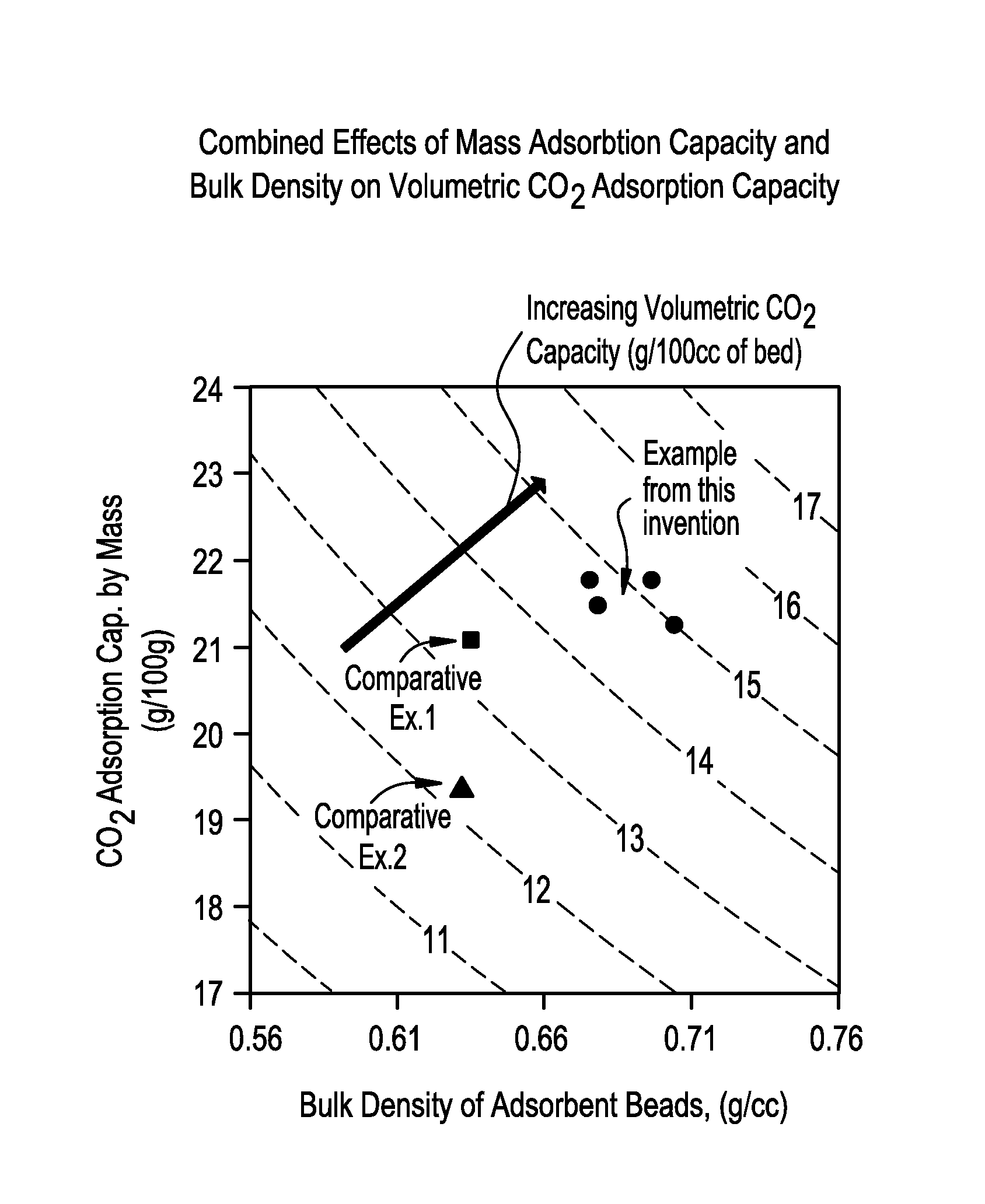Improved Zeolite Particles For Adsorption and/or Desorption of Gases and Liquids
a technology of adsorption and/or desorption of gases and liquids, which is applied in the field of adsorption compositions, can solve the problems of reducing the adsorption capacity of gas loaded adsorbent particles, limiting the amount of desired gas available, and reducing the efficiency of the process, so as to achieve enhanced volumetric gas adsorption capacity, high zeolite content, and high adsorption efficiency
- Summary
- Abstract
- Description
- Claims
- Application Information
AI Technical Summary
Benefits of technology
Problems solved by technology
Method used
Image
Examples
example 1
[0077]Un-activated Zeolite 13X powder (2300 g) was placed in an Eirich Mixer (Type R02). While mixing on high rotating tool speed and low rotating pan speed, 1100 g of pH 7 adjusted colloidal silica binder solution (795.5 g Ludox® HS-40+˜46 g 9% H2SO4+balance of H2O) was added slowly followed by additional mixing for 8.5 min. The mixer was stopped, walls of the pan scraped followed by mixing (high rotary tool, low pan speed) for 3.0 min. While running the mixer on low rotor speed and low pan speed water was added in increments of 25 ml, 10 ml, 10 ml, 10 ml, 10 ml and 5 ml with continued 5.0 min mixing periods after each addition. The beads formed were on the order 1.72 mm. The beads were dried at 250 F overnight followed by calcination at 1050 F for 2.5 hrs (TV (1750 F, 1 hr)=1.23% CO2 adsorption=21.8 wt %, Bulk density=0.675 g / cc).
example 2
[0078]Un-activated Zeolite 13X powder (2300 g) was placed in an Eirich Mixer (Type R02). While mixing on high rotating tool speed and low rotating pan speed, 1100 g of pH 7 adjusted colloidal silica binder solution (795.5 g Ludox® HS-40+˜46 g 9% H2SO4+balance of H2O) was added slowly followed by additional mixing for 8.5 min. The mixer was stopped, walls of the pan scraped followed by mixing (high rotary tool, low pan speed) for 3.0 min. While running the mixer on low rotor speed and low pan speed 10 ml of water was added followed by 10 min of mixing. Further additions of water in increments of 5 ml, with continued 5.0 min mixing periods after each addition was repeated 8 times followed by a final 5 ml of water addition and a mix time of 10 min. The beads formed were on the order 1.60 mm. The beads were dried at 250 F overnight followed by calcination at 1050 F for 2.5 hrs (TV (1750 F, 1 hr)=1.21%, CO2 adsorption=21.3 wt %, Bulk density=0.704 g / cc).
example 3
[0079]Un-activated Zeolite 13X powder (2300 g) was placed in an Eirich Mixer (Type R02). While mixing on high rotating tool speed and low rotating pan speed, 1100 g of pH 7 adjusted colloidal silica binder solution (795.5 g Ludox® HS-40+˜46 g 9% H2SO4+balance of H2O) was added slowly followed by additional mixing for 8.5 min. The mixer was stopped, walls of the pan scraped followed by mixing (high rotary tool, low pan speed) for 3.0 min. While running the mixer on low rotor speed and low pan speed 15.6 ml of water was added followed by 10 min of mixing. Further additions of water in increments of 4.8 ml, 4.9 ml, 4.8ml, 4.7 ml, 5.5 ml, 6.1 ml, and 3.6 ml with continued 5.0 min mixing periods after each addition. The beads formed were on the order 1.60 mm. The beads were dried at 250° F. overnight followed by calcination at 1050 F for 2.5 hrs (TV (1750 F, 1 hr)=1.15%, CO2 adsorption=21.8 wt. %, Bulk density=0.696 g / cc).
PUM
| Property | Measurement | Unit |
|---|---|---|
| mean diameter | aaaaa | aaaaa |
| density | aaaaa | aaaaa |
| density | aaaaa | aaaaa |
Abstract
Description
Claims
Application Information
 Login to View More
Login to View More - R&D
- Intellectual Property
- Life Sciences
- Materials
- Tech Scout
- Unparalleled Data Quality
- Higher Quality Content
- 60% Fewer Hallucinations
Browse by: Latest US Patents, China's latest patents, Technical Efficacy Thesaurus, Application Domain, Technology Topic, Popular Technical Reports.
© 2025 PatSnap. All rights reserved.Legal|Privacy policy|Modern Slavery Act Transparency Statement|Sitemap|About US| Contact US: help@patsnap.com

